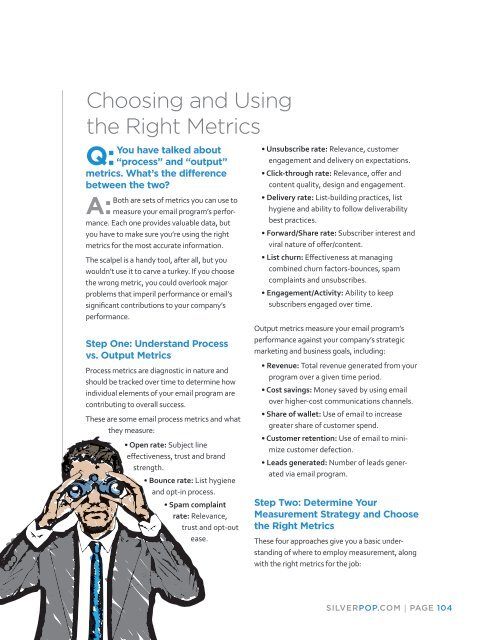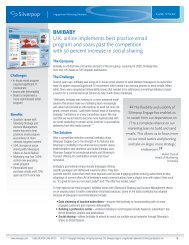eBook - Silverpop
eBook - Silverpop
eBook - Silverpop
You also want an ePaper? Increase the reach of your titles
YUMPU automatically turns print PDFs into web optimized ePapers that Google loves.
Choosing and Using<br />
the Right Metrics<br />
You have talked about<br />
Q: “process” and “output”<br />
metrics. What’s the difference<br />
between the two?<br />
Both are sets of metrics you can use to<br />
A: measure your email program’s performance.<br />
Each one provides valuable data, but<br />
you have to make sure you’re using the right<br />
metrics for the most accurate information.<br />
The scalpel is a handy tool, after all, but you<br />
wouldn’t use it to carve a turkey. If you choose<br />
the wrong metric, you could overlook major<br />
problems that imperil performance or email’s<br />
significant contributions to your company’s<br />
performance.<br />
Step One: Understand Process<br />
vs. Output Metrics<br />
Process metrics are diagnostic in nature and<br />
should be tracked over time to determine how<br />
individual elements of your email program are<br />
contributing to overall success.<br />
These are some email process metrics and what<br />
they measure:<br />
• Open rate: Subject line<br />
effectiveness, trust and brand<br />
strength.<br />
• Bounce rate: List hygiene<br />
and opt-in process.<br />
• Spam complaint<br />
rate: Relevance,<br />
trust and opt-out<br />
ease.<br />
• Unsubscribe rate: Relevance, customer<br />
engagement and delivery on expectations.<br />
• Click-through rate: Relevance, offer and<br />
content quality, design and engagement.<br />
• Delivery rate: List-building practices, list<br />
hygiene and ability to follow deliverability<br />
best practices.<br />
• Forward/Share rate: Subscriber interest and<br />
viral nature of offer/content.<br />
• List churn: Effectiveness at managing<br />
combined churn factors-bounces, spam<br />
complaints and unsubscribes.<br />
• Engagement/Activity: Ability to keep<br />
subscribers engaged over time.<br />
Output metrics measure your email program’s<br />
performance against your company’s strategic<br />
marketing and business goals, including:<br />
• Revenue: Total revenue generated from your<br />
program over a given time period.<br />
• Cost savings: Money saved by using email<br />
over higher-cost communications channels.<br />
• Share of wallet: Use of email to increase<br />
greater share of customer spend.<br />
• Customer retention: Use of email to minimize<br />
customer defection.<br />
• Leads generated: Number of leads generated<br />
via email program.<br />
Step Two: Determine Your<br />
Measurement Strategy and Choose<br />
the Right Metrics<br />
These four approaches give you a basic understanding<br />
of where to employ measurement, along<br />
with the right metrics for the job:<br />
SILVERPOP.COM | PAGE 104







